Having trouble retaining information? Learn how to master studying with these top 10 techniques backed by educational psychology research.
Are you eager to elevate your study game and become a master learner? This guide explores ten proven study methods designed to make your learning process more effective and enjoyable.
Drawing on insights from educational psychology, we'll unpack each technique and share tips to help you master new skills more efficiently.
Effective study methods fall into four broad categories: active learning, passive learning, practice-based learning, and memory-based learning.

Active learning engages students directly in the learning process, promoting better retention and critical thinking.
These methods promote deeper engagement and foster a collaborative classroom environment.

Though less interactive, passive learning still builds foundational knowledge.
To maximize results, blend passive methods with more active techniques.

Practice-based methods emphasize learning by doing.
These techniques promote long-term engagement and real-world readiness.

These methods support information retention and long-term recall.
Each reinforces recall through repetition and active engagement.
From structured reading systems to spaced repetition, the following techniques are evidence-based and effective.

This structured approach builds comprehension and memory.
Actively recall information rather than passively rereading. Examples include quizzes, flashcards, or explaining content aloud. This method strengthens memory and improves long-term retention.

Spread learning sessions over days or weeks instead of cramming. Space increases information retention and reduces mental fatigue.
Designed to boost comprehension and recall through a multi-step process.

Simplify concepts by explaining them in your own words. This reveals knowledge gaps and helps deepen understanding.
Writing by hand improves memory. Rewriting or summarizing lectures reinforces understanding and improves recall.

Condense reading materials into key points. Helps students identify main ideas and improves critical thinking.
Simulate exam conditions using quizzes and flashcards. This reinforces content and highlights areas needing review.

Use acronyms, rhymes, or visual associations to simplify memory. Ideal for memorizing complex or sequential content.
Create mental images, diagrams, or mind maps. Helps clarify complex ideas and supports long-term memory.

Whether you're studying for exams or learning a new topic, apply the following:
Observe how you process information best—visually, aurally, or kinesthetically—and tailor your methods accordingly.

Divide complex tasks into manageable chunks to reduce overwhelm and maintain momentum.
Organize ideas graphically to better understand connections between concepts.

Explaining a concept to someone else strengthens your own understanding and uncovers gaps in knowledge.

Make studying a habit. Even 20–30 minutes daily builds strong long-term retention.
Create achievable goals to stay focused and track progress.
Stick to a schedule. Regular short sessions beat occasional cramming.

Enhance your performance by incorporating lifestyle habits into your learning routine.
Choose a distraction-free study zone, align study techniques with your style, and care for your mental and physical health.
Reduce noise, disable notifications, and keep study sessions focused.

Memory consolidation happens during sleep. Prioritize 7–9 hours of quality rest each night.
Exercise, mindfulness, and breaks boost concentration and reduce burnout.

Use mnemonics, self-quizzing, and chunking to improve recall and engagement.
Stick to a regular schedule. Study in blocks with breaks to improve focus.
Plan study sessions, set deadlines, and avoid multitasking. Use timers or apps to stay on track.
Identifying and addressing common barriers helps maintain focus and drive.

Use task breakdowns, clear goals, and supportive environments to avoid delay.
Create a quiet, tech-free space or use tools like noise-canceling headphones.
Set meaningful goals and celebrate small wins. Personal relevance increases engagement.
Use platforms like Quizlet, Google Docs, or learning apps for collaborative and solo study.
Promote a growth mindset by encouraging students to ask questions and seek assistance.
This guide offers a comprehensive toolkit for students and educators looking to improve study efficiency and academic outcomes. By combining proven techniques with structured practice and self-awareness, learners can achieve mastery in any subject.
